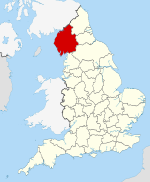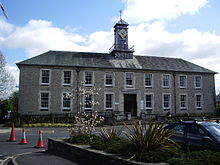- Cumbria County Council
-
Cumbria County Council 10th four-year term 
Type Type Unicameral Leadership Leader Eddie Martin (Conservative) Members 84 Political groups Conservatives 37
Labour Party 24
Liberal Democrats 16
Independents 7Elections Voting system First past the post Last election 4 June 2009 Meeting place 
County Hall, Kendal, Cumbria, LA9 4RQ Website cumbria.gov.uk Cumbria County Council is the county council of Cumbria, a county in the North West of England. Established in 1974, following its first elections held a year before that, it is an elected local government body responsible for the most significant local services in the county, including county schools, county roads, and social services.
Contents
Creation
In 1974, under the Local Government Act 1972, the administrative counties of Cumberland and Westmorland and the county borough of Carlisle were abolished, and the areas they covered were combined with parts of Lancashire and parts of the West Riding of Yorkshire to form a new administrative county called Cumbria.[1]
Functions
Cumbria County Council is responsible for the more strategic local services of the county, including education (schools, both primary and secondary), libraries and youth services, social services, highway maintenance, waste disposal, emergency planning, consumer protection, and town and country planning for minerals matters, waste and for highways. This makes it a substantial employer.
The former Cumberland County Council's final major road scheme, an A66 bypass for Keswick, was prepared by Scott Wilson Kirkpatrick, consulting engineers, in 1972,[2] and construction began in the summer of 1974, with the new authority completing the scheme.[3]
History
Control of the council has swung back and forth. In its first four years (1973-1977) there was no overall control, but in 1977 the Conservatives gained a majority. In 1981, this became a majority for Labour, and from 1985 there was again no one-party control. In 1997, Labour again took control, but lost it in 2001. Since then, no party has had a majority.
A proposal for Cumbria to become a unitary authority was made in 2007,[4] and Cumbria went into consultation, with opposition coming from the district councils which would be abolished, Allerdale, Barrow-in-Furness, Carlisle, Copeland, Eden, and South Lakeland.[5] In the event, the county was left out of the 2009 structural changes to local government in England.[6]
In 2008, the county council rejected a proposal to introduce a directly elected mayor, opting instead for a cabinet-style administration that resembled the status quo.[7] During the same year, an administration of Conservatives and Liberal Democrats collapsed, suffering not least from lacking a majority in the council. Thirty-nine Labour members and three Independents exactly equalled the total of thirty-two Conservatives and ten Liberals. A minority Labour administration then took over running the council until the June 2009 elections, when a net gain of one seat from the Independents led to the creation of a new Conservative and Liberal Democrat coalition.[8]
Elections
The first elections to the authority were in 1973, and members have been elected since then every four years for a four-year term of office, with elections being held all together on the "first past the post" system.
Since boundary changes in 2001, 84 councillors have been elected from 84 single-member electoral divisions.[9]
At the June 2009 elections, the outcome was 38 Labour members, 24 Conservatives, 16 Liberal Democrats and six Independents.
Political control
Since 1973 the political control of the council has been as follows:[10]
Party in control Years No overall control 1973 - 1977 Conservative 1977 - 1981 Labour 1981 - 1985 No overall control 1985 - 1997 Labour 1997 - 2001 No overall control 2001 - present Notable members
- Tim Westoll, first chairman of the Council, previously chairman of Cumberland County Council from 1959 to 1974.[11]
See also
Notes
- ^ Local government in England and Wales: A Guide to the New System. London: HMSO. 1974. ISBN 0117508470.
- ^ Civil engineering and public works review, vol. 67, Issues 792-797 (1972), p. 715
- ^ Tony Aldous, Goodbye Britain? (1975), p. 171
- ^ "Twenty-six councils bid to become unitary authorities". webmaster. 2007-01-26. http://www.24dash.com/news/Local_Government/2007-01-26-Twenty-six-councils-bid-to-become-unitary-authorities. Retrieved 2011-01-01.
- ^ Julian Whittle (2007-03-30). "Big step forward for unitary authority bid". The Whitehaven News. http://www.whitehaven-news.co.uk/1.167901. Retrieved 2011-01-01.
- ^ "Woolas announces sixteen successful bids for unitary status to improve local services". eGove monitor. 2007-03-27. http://www.egovmonitor.com/node/10037. Retrieved 2011-01-01.
- ^ "Council rules out elected mayor". BBC News. 2008-09-14. http://news.bbc.co.uk/1/hi/england/cumbria/7615511.stm. Retrieved 2011-01-01.
- ^ Julian Whittle, Political fight begins for control of Cumbria council dated 12 May 2009 at newsandstar.co.uk, accessed 1 January 2011
- ^ "Welcome to Council and Democracy". Cumbria County Council. http://www.cumbria.gov.uk/council-democracy/default.asp. Retrieved 2011-01-01.
- ^ "Cumbria". BBC News Online. 19 April 2009. http://news.bbc.co.uk/1/shared/bsp/hi/elections/local_council/09/html/3853.stm. Retrieved 2011-01-01.
- ^ Elizabeth Hughes, Obituary: Tim Westoll, dated 12 February 1999, in The Independent online
Ceremonial county of Cumbria Cumbria Portal Boroughs or districts City of Carlisle • Borough of Allerdale • Borough of Barrow-in-Furness • Borough of Copeland • District of Eden • District of South LakelandMajor settlements Alston • Ambleside • Appleby-in-Westmorland • Aspatria • Barrow-in-Furness • Bowness-on-Windermere • Brampton • Broughton-in-Furness • Carlisle • Cleator Moor • Cockermouth • Dalton-in-Furness • Egremont • Grange-over-Sands • Harrington • Kendal • Keswick • Kirkby Lonsdale • Kirkby Stephen • Longtown • Maryport • Millom • Penrith • Sedbergh • Silloth • Ulverston • Whitehaven • Wigton • Windermere • Workington
See also: List of civil parishes in CumbriaTopics Demography • Economy • Education • Geography • History • People • Places of interest • Settlements • Sport • Symbols and county emblems • TransportCounty councils of England Buckinghamshire · Cambridgeshire · Cumbria · Derbyshire · Devon · Dorset · East Sussex · Essex · Gloucestershire · Hampshire · Hertfordshire · Kent · Lancashire · Leicestershire · Lincolnshire · Norfolk · North Yorkshire · Northamptonshire · Nottinghamshire · Oxfordshire · Somerset · Staffordshire · Suffolk · Surrey · Warwickshire · West Sussex · WorcestershireCategories:- Local government in Cumbria
- History of Cumbria
- Politics of Cumbria
- County councils of England
Wikimedia Foundation. 2010.
